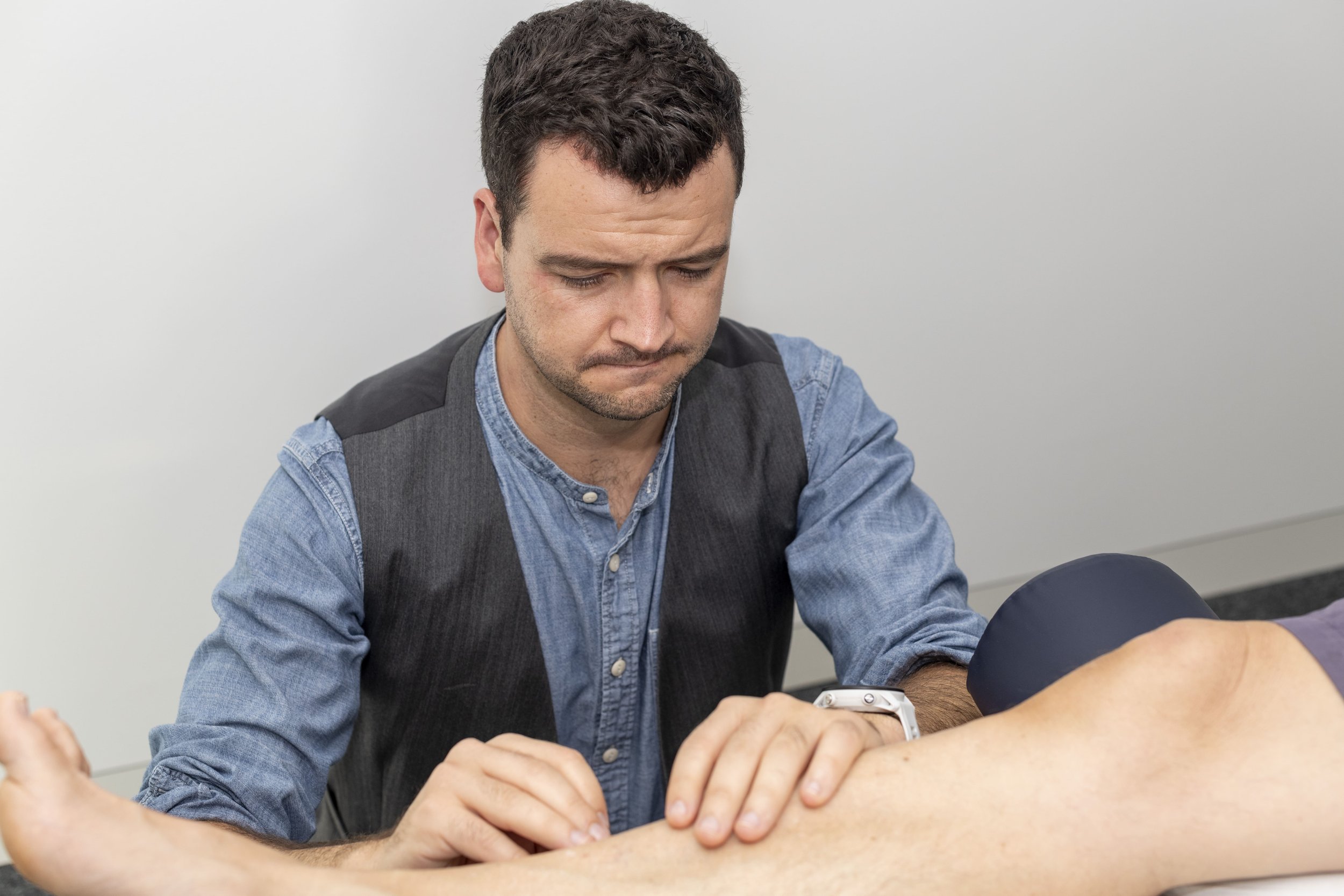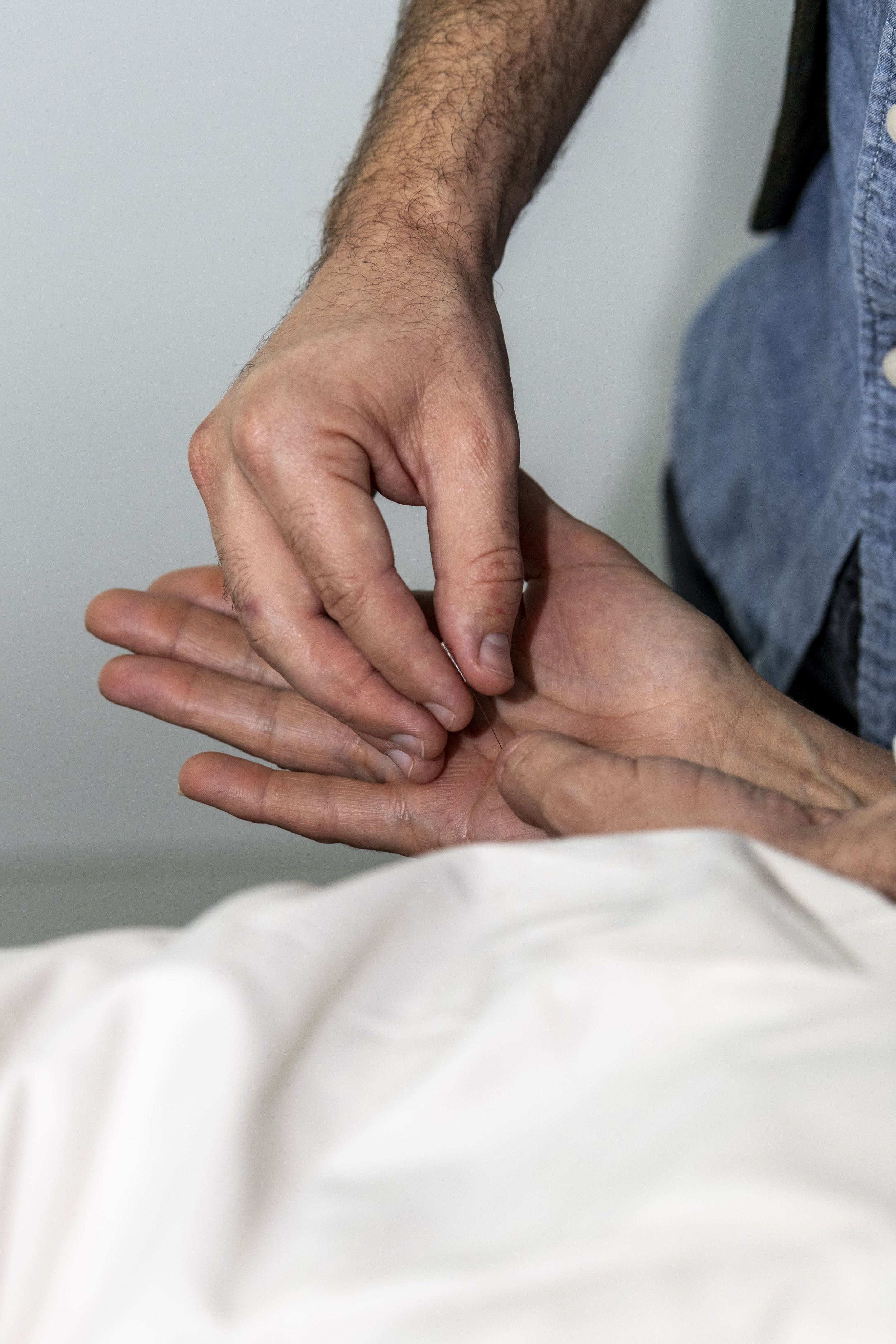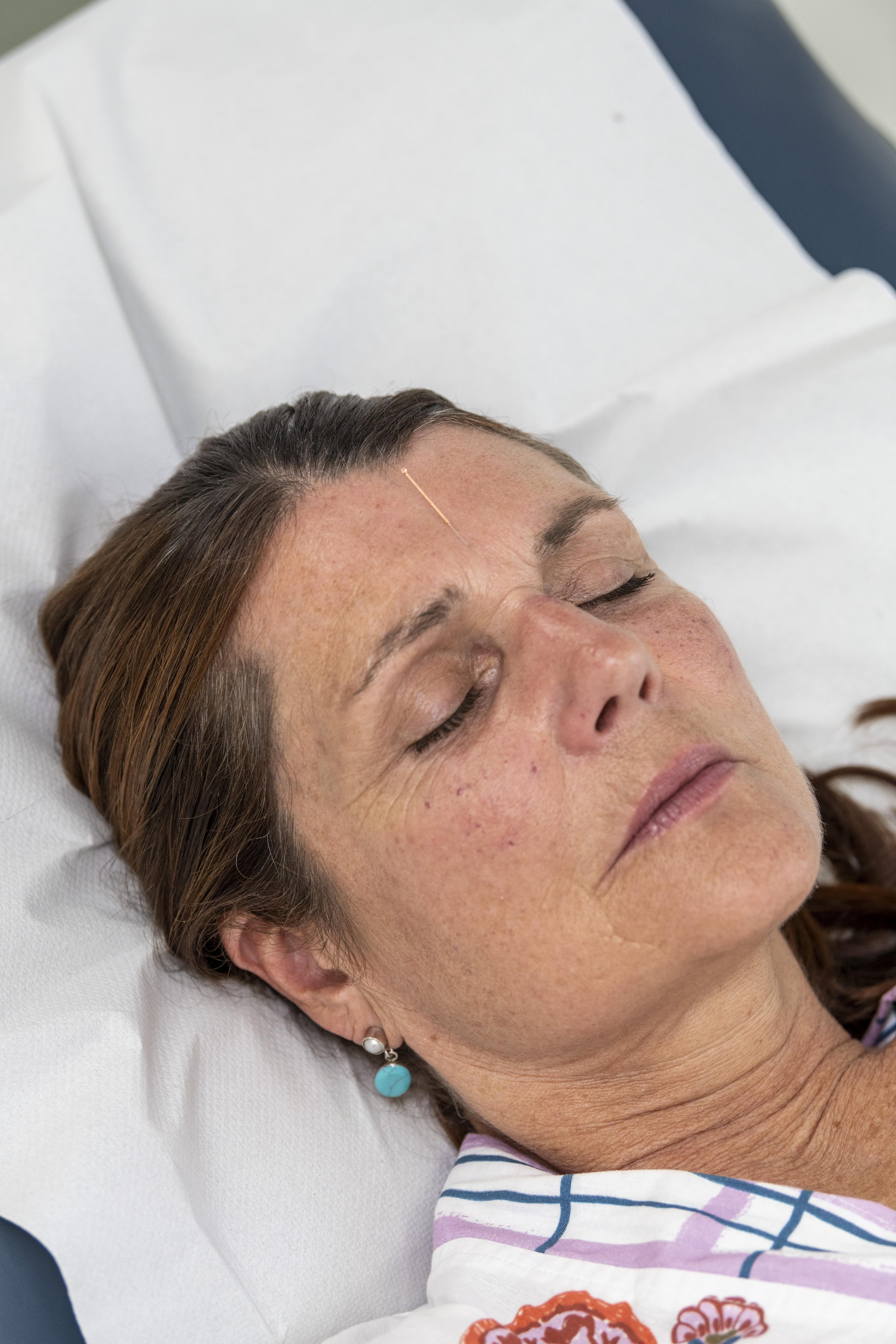
What Is Acupuncture?
Acupuncture is one of the four pillars of Chinese Medicine alongside Herbs and Nutrition, Physical Manipulation, and Qi Gong. Acupuncture uses very thin needles to influence and balance the body’s energy.
BACKGROUND OF ACUPUNCTURE
The history of acupuncture stretches back thousands of years, making it one of the oldest medical practices in the world. Its origins are believed to be in ancient China. While the exact timeline and origins are shrouded in legend and mythology, archaeological findings suggest that acupuncture may have been practiced as early as the Stone Age, with the use of sharp stones or bone needles to puncture the skin for therapeutic purposes.
The foundational text of Chinese medicine, known as the Huangdi Neijing or Yellow Emperor's Inner Canon, is believed to have been written around 300 BCE and provides some of the earliest references to acupuncture and its theories. According to legend, the Yellow Emperor himself, a legendary figure in Chinese history, is said to have learned about the art of acupuncture from his chief medical advisor, Qi Bo.
Throughout the centuries, acupuncture evolved and was refined based on observations, trial and error, and accumulated knowledge. It became an integral part of traditional Chinese medicine and was used to treat a wide range of ailments and conditions.
Acupuncture spread beyond China's borders, reaching neighbouring Asian countries like Korea and Japan, where it was further integrated into their respective traditional medical practices. Over time, different styles and techniques of acupuncture developed in these regions, each with its unique characteristics and methods.
In the 17th century, Western missionaries and travellers began to document their encounters with acupuncture in China, sparking interest in Europe. However, it was not until the 20th century that acupuncture gained significant attention and acceptance in the West. Acupuncture's popularity increased in the 1970s when New York Times journalist James Reston reported on its successful use for pain relief during his trip to China.
Since then, acupuncture has become widely recognized and practiced globally, not only within the framework of TCM but also as a complementary therapy within conventional medical settings. Today, research continues to explore its effectiveness and the underlying mechanisms behind its therapeutic benefits, solidifying acupuncture's place as a respected and enduring medical practice with a rich history spanning millennia.
Underlying philosophy
Within Chinese Medicine there are traditionally five key pillars that are said to lead to longevity and good health. Two of these pillars are Acupuncture and Moxibustion which have both been used for centuries to help people maintain their health. The general premise of Chinese Medicine can be seen through the lens of yin and yang (陰陽); the philosophy of balance.
There is always a balance, two opposing forces working in unison, that keeps things working in harmony. Some examples of these opposite but complementary forces include:
With light (yang) there must be darkness (yin)
With day (yang) there must be night (yin)
With Summer (yang) there must be winter (yin)
With activity (yang) there must be rest (yin)
This is the simplest way that we can understand health. Health only occurs when we are in balance. This could be in terms of our activity, in terms of acting in accordance with the seasons, or through the working of our bodies.
How does acupuncture work
As explored, our ill health only occurs when our bodies are out of balance. Acupuncture works by being able to adjust the flow of “Qi”, life’s breath, to restore the balance within our body.
Imagine your body as a network of interconnected pathways known as meridians, through which life force energy, or Qi, flows. When this energy becomes blocked or imbalanced, it can lead to various health issues.
Acupuncture works by the practitioner inserting needles into specific points along these meridians, which triggers the body's natural healing response. But don't worry; the needles are ultra-fine and cause minimal discomfort, often akin to a slight tingling sensation (although everyone experiences things differently). Once inserted, these needles help unblock the Qi, allowing it to flow freely, restoring balance and promoting optimal health.
But that's not all—acupuncture also causes a release of endorphins, our body's very own natural painkillers, which can help to alleviate pain and improve our overall well-being.
What are the different approaches that i practice?
With it’s origins being over 2,000 years old, whilst beginning in China, there have been a lot of evolutions over the last few thousands of years. Throughout its long history, different styles of acupuncture have emerged, where each one has its own unique approaches and principles. Here are some quick overviews of the styles of acupuncture that I use as part of my treatments:
-
TCM is probably the most well-known and widely practised style of acupuncture worldwide. It’s basis is formed on the vast depth of classical acupuncture but in some respects simplifies things into a series of patterns. A practitioner’s role is to understand the complaints, match this to a particular pattern (for example Liver Yang Rising) and then use a protocol approach to treat that pattern and restore harmony.
-
Five Element Acupuncture places the concept of the Five Phases at the forefront of our treatments. The philosophy comes from the fundamental belief that these five phases (Wood, Fire, Earth, Metal and Water) govern the natural world and the human body. This style views health as a harmonious interaction between these elements. When there is an imbalance or disharmony, illness may arise. By assessing a person's symptoms and constitution, the practitioner identifies which element is out of balance and selects specific acupuncture points to restore equilibrium. The Five Phases acupuncture approach aims to address both physical and emotional aspects of health, recognizing the interconnectedness of the mind and body.
-
This style of acupuncture can be seen through two different perspectives. The first being how a disharmony in the body can be affected by the seasons and the external climates; a great example being that the common cold is often seen through an invasion of wind-cold through the Tai Yang division. This helps us to be able to treat disease caused by the external climates. The second way that this approach can be used is through the understanding how each division helps the body to work as a functional pair. By knowing what happens when we are in health, we can then reverse engineer this to understand what causes pathological issues.
-
This is a less common style of acupuncture but one that my college specialises in. Its roots are in the classical text of the Huangdi Neijing (Yellow Emperor’s Inner Cannon) which is one of the most foundational texts of classical acupuncture. This style of acupuncture uses the time and date of a person’s birth to determine their own unique energy patterns (almost like a Chinese Astrology). The practitioner will identify specific meridians and acupuncture points that are particularly powerful based on the date of birth to both treat curatively but also preventatively. Stems and Branches places a huge emphasis on how the influence of the cosmic and seasonal factors affect our health and wellbeing.
-
Master Tung acupuncture stands out for it has its very unique way of treating. Its innovative methods utilise a separate group of acupuncture points (there are over 700 points) that are not found in other acupuncture systems. They’re based on Master Tung’s experience of treating over 400,000 patients over the course of his lifetime. They are well renowned for their exceptional potency and they often produce rapid and profound results.
These are just some styles of acupuncture. They are the ones that I am currently trained in. Each style offers a unique perspective to our health, with a different emphasis placed on the lens that the practitioner uses, but they all support the patient to return back to full health. Having the experience of multiple styles means that the practitioner can have the flexibility to chose what they think will most help the patient but over time, the practitioner can find the style that most suits the patient too.
The Process of Acupuncture
Here's a brief description of what you can expect during an acupuncture session:
Initial Conversation: The first part in an acupuncture treatment involves an initial assessment by the acupuncturist. They will inquire about your medical history, current health concerns, lifestyle, and any symptoms you may be experiencing. This is an in depth consultation where we go very deep into your current and previous health systems. This information helps the acupuncturist understand your unique health condition and create a fully personalised treatment plan.
Physical Examination: The practitioner will then often palpate the channels on your arms and legs, palpate your abdomen, looking at your tongue, feel your pulses and more. Palpating the channels and feeling your pulses relate to how your meridians are functioning. Feeling the abdomen and looking at the tongue give us a sense of how your organs themselves are functioning. These two aspects are interrelated but different and we want to know how each was performing separately.
Diagnosis: Based on the information gathered, the acupuncturist will make a diagnosis according to the principles of a chosen acupuncture style like the ones explained earlier (e.g., Traditional Chinese Medicine, Five Phases, etc.). They will identify patterns of disharmony within your body, such as imbalances in Qi (life force energy) or disruptions in the flow of energy along specific meridians.
Needle Insertion: After the diagnosis has been made the treatment can start. This is the best bit where you can lie comfortably on a treatment table and relax. The acupuncturist will then insert fine, sterile needles into specific acupuncture points on your body. You may feel different sensations depending on the points selected, what your body needs and the way that the practitioner manipulates the needle. The number of needles used can vary depending on your condition and the acupuncturist's approach but typically is between 4-10 needles. The needles are usually left in place for between 15 to 30 minutes.
Treatment Plan: After the treatment, the acupuncturist will discuss a plan with you. This plan will outline the number of sessions recommended, the frequency of treatments, and the specific acupuncture points to be targeted during each session. The purpose is to come to a shared agreement that will help you achieve your goals.
In addition to just using needles, the practitioner could incorporate other techniques into the session. This could include moxibustion (the burning of a herb near acupuncture points), cupping (placing cups on the skin to create a suction effect), or some forms of massage.
WHAT ACUPUNCTURE CAN HELP WITH
From Research
Acupuncture is a versatile form of complementary medicine that can address various health conditions. Because it is less interested in a ‘Western’ medical term, it is incredibly effective at treating the symptoms that you have. Here are some of the different conditions that acupuncture has shown efficacy in helping:
Pain Management: Acupuncture is well-known for its effectiveness in managing various types of pain, including chronic pain, back pain, neck pain, osteoarthritis, headaches, migraines, and menstrual pain.
Stress and Anxiety: Acupuncture can help reduce stress, anxiety, and promote relaxation by stimulating the release of endorphins and other neurotransmitters that induce a sense of calm and well-being.
Digestive Issues: Acupuncture has been used to alleviate digestive problems like irritable bowel syndrome (IBS), acid reflux, bloating, and constipation.
Insomnia and Sleep Disorders: Acupuncture may aid in improving sleep quality and treating insomnia by regulating the body's natural sleep-wake cycle.
Women's Health: Acupuncture is often used to address women's health issues, such as menstrual irregularities, fertility support, menopausal symptoms, and pregnancy-related discomforts.
Respiratory Conditions: Acupuncture can be beneficial in managing respiratory conditions like allergies, sinusitis, asthma, and bronchitis.
Immune System Support: Some studies suggest that acupuncture may help enhance the immune system's function, potentially reducing the frequency and severity of infections.
Mental Health: Acupuncture may play a role in supporting mental health by helping with depression, mood disorders, and emotional imbalances.
Nausea and Vomiting: Acupuncture is frequently utilized to relieve nausea and vomiting caused by chemotherapy, pregnancy (morning sickness), or postoperative recovery.
Chronic Fatigue: Acupuncture may aid in boosting energy levels and reducing fatigue associated with chronic illnesses or stress.
Addictions: Some individuals use acupuncture as part of a comprehensive treatment plan to reduce cravings and withdrawal symptoms related to addiction.
Immune System Support: Acupuncture has been associated with modulating the immune system, potentially benefiting people with autoimmune conditions.
It's important to note that acupuncture is considered a complementary therapy and should not be used as a substitute for conventional medical treatments in severe or life-threatening conditions. If you are considering acupuncture, consult with a qualified and licensed acupuncturist who can assess your specific health needs and develop a suitable treatment plan.
From Personal experience
Here is a more exhaustive list of some of the conditions that Josh has treated in his clinics:
Muscular Pains (Neck, Shoulders, Back, Knee, Leg, Foot)
Autoimmune Conditions
Sleep Issues
Tennis Elbow
Frozen Shoulder
Tooth Ache
Colds and Flu
Polymyalgia
Diabetes
Digestive Conditions (IBS, Constipation, Diverticulitis, and more)
Sciatica
Headaches and Migraines
Mental Health
Chronic Fatigue Syndrome
Women’s Health (Menstrual Pain, Fertility, Gynae)
Regular Maintenance
Cancer (E.g. Reducing Side Effects from Chemo)
FAQs
-
Acupuncture is generally considered a safe and non-invasive therapy that should not cause significant pain. However, some people may experience minor discomfort or a sensation of pressure or tingling at the acupuncture points during the insertion of the needles.
Acupuncture needles are typically much thinner than hypodermic needles used for injections, and most people find the insertion process to be painless. The needles are also typically inserted only a few millimeters into the skin, so they do not cause deep tissue damage or pain.
During the acupuncture session, you may feel a sensation of warmth, tingling, or heaviness in the area around the acupuncture points. This is a sign that the energy flow in your body is being stimulated, and it is considered a positive indication that the treatment is working.
-
When going for an acupuncture treatment, it's recommended to wear loose, comfortable clothing that can easily be rolled up above the elbows and knees. This will allow the practitioner to access the acupuncture points on your arms and legs, as well as other areas of your body.
It's also a good idea to avoid wearing jewellery or tight clothing that may restrict blood flow or interfere with the placement of the acupuncture needles. Avoiding heavy meals or alcohol before the treatment is also recommended.
In some cases, the practitioner may ask you to change into a gown or other loose-fitting clothing provided by the clinic. This is to ensure that the acupuncture points are easily accessible and that there are no obstructions that could interfere with the treatment.
Overall, the goal is to wear clothing that is comfortable and allows for easy access to the areas of your body that will be treated.
-
Outside of college, I would imagine that most practitioners would typically take between 45-60 minutes for each treatment.
Currently, at the college our treatments last 2 hours however there is no charge for these treatments. It is slightly longer so that we can have adequate time to conduct an interview, do a clear diagnosis, discuss the best points to use, and needling itself.
-
Absolutely not. A lot of people have treatments to maintain their health and prevent disease.
A lot of the work we do is about balancing the body, and more technically balancing the pulses, so there is no need to have a clear condition. Although, if you do then we can work on that of course.
It is a time for you to heal and work on improving your health. I think some people just like the treatments to have an hour to themselves with no distractions, TV, kids, or any other disruptions that they have on a day-to-day basis.
-
The frequency of acupuncture treatments can vary depending on the individual's condition, severity of symptoms, and overall health. In general, it's recommended to start with weekly treatments and then adjust the frequency as necessary based on the response to treatment.
For acute conditions such as a cold or sprain, you may only need one or two treatments to see significant improvement. For chronic conditions such as chronic pain or migraines, a series of regular treatments over several weeks or months may be necessary to achieve lasting relief.
Some people may choose to have ongoing maintenance treatments every 4-6 weeks to support their overall health and prevent the recurrence of symptoms.
Ultimately, the recommended frequency of acupuncture treatments will depend on your individual needs and the recommendations of your practitioner. It's important to communicate openly with your practitioner about your symptoms and progress to ensure that you are receiving the appropriate level of care.
-
This depends on what your condition is. However, the treatments typically are between 4-10 needles going across your limbs, your front and back.



